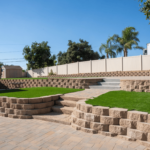Tracing the Roots of Landscaping
The art and science of landscape designing, planning, and implementing outdoor spaces into aesthetically pleasing and functional environments are known as Landscaping. It is a multidisciplinary yield that transforms outdoor spaces into beautiful living masterpieces. It does that by merging elements of horticulture, architecture, urban planning, and environmental science. Landscaping plays an important role in enhancing the beauty and functionality of areas like backyards, public parks, corporate campuses, or even streetscapes while fostering a connection between nature and humanity.
When the designing and organizing of outdoor spaces was integral to human settlements, you can trace back the roots of landscaping to ancient civilizations. a great example of this is the gardens of Babylon and the Hanging Garden of Semirams in ancient Mesopotamia. These are early examples of meticulously planned and structured landscapes. They represent the ingenuity and aesthetic sensibilities of their creators.
East Meets West
Various cultures and traditions throughout history have contributed to the evolution of landscaping practices. If we look at the East Japanese and Chinese have profound respect for nature. Leading to the creation of traditional garden designs that harmonize with the natural environment. Moreover, they have gardens that often incorporate elements like water features, pruned plants, and symbolic structures. This helps create a serene and meditative atmosphere.
However, in the Western world, the concept of landscaping gained importance during the Renaissance period. This is when scholars and artists sought to revive the classical principles of symmetry and beauty. Moreover, the Italian Renaissance gardens, characterized by geometric designs, ornate fountains, and statues furthermore became the foundation of formal gardens all across Europe.
Landscaping in the Modern Era
A rise in Landscape architecture was witnessed in the 19th century as a distinct profession. The father of American landscape architecture, Frederick Law Olmsted, designed the central park a world-renowned landscape also the Emerald Necklace in Boston. Olmsted’s philosophy of making public areas that promote community engagement and social interplay laid the groundwork for cutting-edge urban planning and park layout.
As urbanization accelerated and green spaces diminished in the 20th century, landscaping gained a sense of significance and urgency. To beautify outdoor spaces and also address critical environmental and social issues is what Landscaping aims for.
- Environmental Sustainability: To create environmentally sustainable designs, soil restoration, water conservation, native plant selection, etc landscaping embraces all these ecological principles. Landscapers contribute to mitigating issues like urban heat islands and stormwater runoff by incorporating green infrastructure like rain gardens, green roofs, and permeable pavements.
- Biodiversity Conservation: in preserving and the enhancement of biodiversity in urban settings landscaping can play a big role in them. By mixing different plant species and giving a suitable habitat for wildlife. A landscaper donates to creating urban ecosystems that support local flora and fauna.
- Human Well-being: in the wellbeing of humans landscaping plays a significant role in impacting them. Studies show that landscaping, well-designed landscapes can reduce tensions and stress and can help improve mental health and foster a sense of community. Whether it’s a vast public park or a small backyard, a good landscape can provide a place for relaxation, recreation, and social interaction.
- Economic Benefits: A well-thought landscaping can help increase the value of both residential and commercial properties. Commercial properties with a well-designed landscape often attract more customers and give them a competitive advantage over their competitors. Similarly, attractive public spaces can drive a country’s tourism, therefore, supporting local economies.
Key Elements of Successful Landscaping
A thoughtful combination of various elements, with each of them playing a specific role in shaping the design creates a successful landscape:
- Plant Selection: Plant selection is at the core of any landscape design. Elements such as climate, soil type, and maintenance requirements are intricately considered to make sure the chosen plants thrive in their environment to the desired aesthetics.
- Hardscape Features: hardscape helps add structure and functionality to the property and landscape. For example pathways, patios, pergolas, and water features. Hardscaping helps create focal points and define spaces furthermore offering popular outdoor activities.
- Lighting: having proper lighting can change a landscape and extend its beauty into the evening. It helps enhance safety and highlights architectural and natural features. It helps set the mood for different areas.
- Textures and Colors: to create visual interest landscape uses different combinations of textures and colors. Contributing to harmonious and captivating designs, landscape interplays between different plan shapes, sizes, and colors along with hardscape materials.
- Sustainability and Maintenance: an important part of landscaping is considering long-term sustainability and maintenance requirements. Low-maintenance plants, efficient irrigation systems, and appropriate landscape management strategies are essential for the success of any project.
From Concept to Implementation and Maintenance
In the process of landscaping there lies several stages all very crucial to bringing a vision to life:
- Site Analysis: a detailed site analysis is conducted before any design work. It asses the current conditions which include topography, soil quality, drainage patterns, and existing vegetation. This helps the design message and helps identify potential problems and opportunities.
- Conceptual Design: this phase involves generating ideas and creating the overall layout in your mind for the landscape. This includes rough sketches, mood boards, and initial ideas that capture the beauty of the project.
- Design Development: in this step, the whole concept is transformed into a detailed plan. Hardscape materials, plant palettes, and lighting are decided. Furthermore, the design starts taking a tangible form.
- Implementation: furthermore, when the design is completed the landscaping team begins to implement it. This process consists of excavation, grading, planting, and construction of hardscape features. Experienced craftsmen and horticulturists simultaneously work together to bring it to life
- Maintenance: lastly after the landscape haven is complete, maintaining is essential for its longevity. For perseverance of its beauty and functionality regular care is important.
Up and-coming 21st-century landscaping
Through the years like any other field, the tastes and trends also develop for landscaping over time. Some notable trends and innovations in landscaping include:
- Sustainable Landscapes: due to the increasing awareness of environmental issues, now people go for sustainable landscaping. These include incorporating drought-tolerant plants, rainwater harvesting systems, and using recycled materials.
- Vertical Landscaping: vertical gardens also known as living walls are a fan favorite in landscaping nowadays. These new innovations bring greenery incorporated in your walls and create stunning visual displays as a part of your landscape.
- Smart Landscaping: smart irrigation systems are a part of the new and upcoming technologies. It adjusts watering schedules depending on weather conditions. moreover, automated lighting and remote monitoring allow for more efficient landscape management.
- Edible Landscapes: another thing that catches the eye is including the growth of food in their landscapes. It gets people interested in sustainable living and connecting with nature. adding edible plants like herbs, fruits, and vegetables into the design adds functionality to the landscape.
The Timeless Appeal of Landscaping
The art of transforming outdoor spaces into serene and functional environments is what landscaping does. It includes a vast history and cultures incorporated into beautiful havens. This is a multidisciplinary field that aims to create sustainable and beautiful spaces. From ancient gardens to modern urban parks, landscaping continues to win the hearts of the people.






